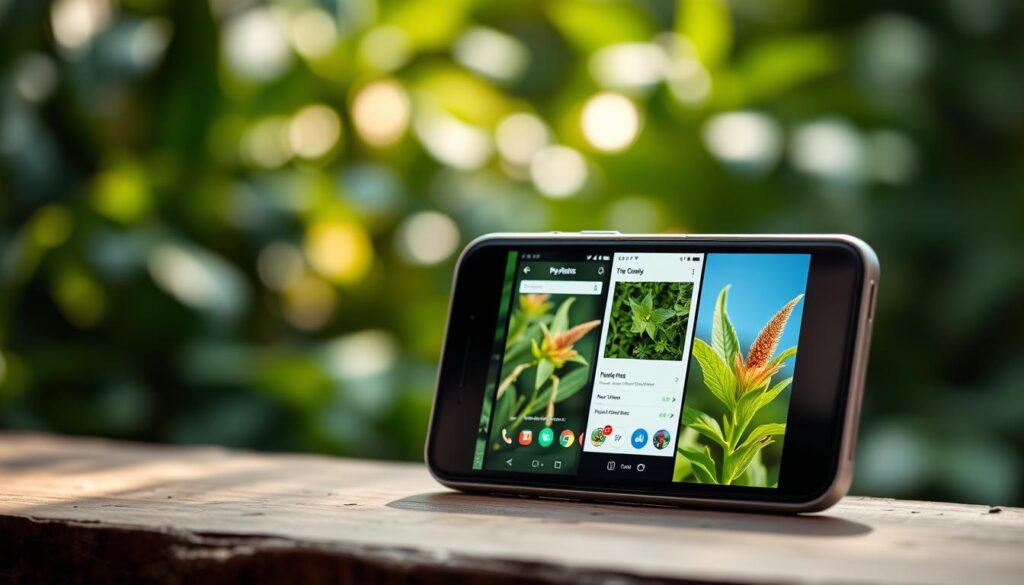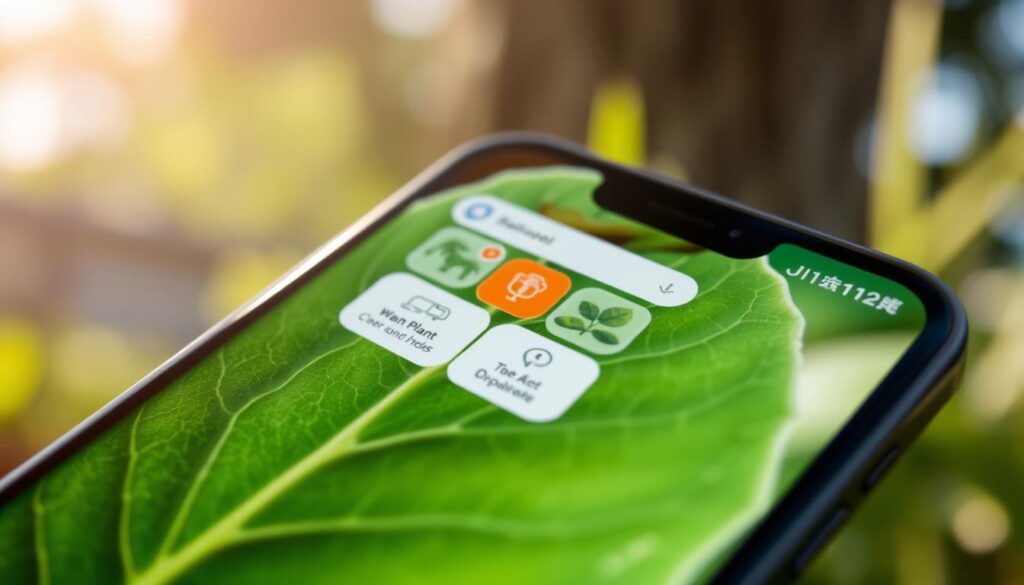Best Free Apps to Identify Plants Easily

About the Game
Want to Learn More About Plants?
Recently, more people want to understand and connect with nature. This has made free plant ID apps very popular. They let you take a photo of a plant and tell you what it is right away.

Seek App
These apps do more than just identify plants. They encourage users to join citizen science projects. This way, users can help with biodiversity. So, for gardeners, teachers, and nature fans, finding the best plant ID apps is key.
Anúncios
Introduction to Plant Identification Apps
Plant identification apps are changing how we interact with nature. They let you snap a photo of any plant to find out what it is. These apps use smart technology and huge plant databases for accurate IDs. This makes it easy for people to learn about plants and enjoy nature more.
These apps are great for anyone, from hobbyists to expert scientists. They help identify unknown plants and provide care tips for houseplants. With these apps, discovering nature becomes both fun and educational.
Anúncios

Why Use Free Apps to Identify Plants
Free plant ID tools make learning about plants easy and cheap. They let nature lovers get to know the wide variety of plants around them. They can do this without spending money. These apps are also educational. They help users learn more about different plant species and their importance in nature.
Using these apps has more benefits than just figuring out what a plant is. They help people learn about plants that could be dangerous and those that might hurt the environment. Knowing about these plants is important for staying safe and for taking care of nature. Plus, these apps help people connect by sharing what they’ve found. This builds a sense of teamwork among users.
In the end, free plant ID apps make it easier for everyone to enjoy nature. They help us learn more and care about the plants in our area. These tools are great for anyone interested in plants, from beginners to expert plant scientists.
Top Features of Plant Identification Apps
Plant identification apps come packed with features to help users. One key feature is photo identification. It lets users snap a photo and get feedback. The app checks the photo against a huge database. This makes identifying plants easy for everyone.
Having a vast plant database is also crucial. These apps offer details on many plant species, including rare ones. This helps users find exactly what they are looking for.
A user-friendly interface is important for these apps. It allows easy navigation for all users. This improves the experience and makes exploring plants more fun.
Community features play a big role too. Users can share what they find with others. This encourages learning together and supports citizen science. It helps users learn more about the plants around them.
Finally, being able to talk to experts stands out. Users can get advice from botanists or seasoned users. This increases the chance of correct plant identification. It turns the app into a valuable tool for those who love nature.
PlantNet: A Leading App for Plant Identification
The PlantNet app is a standout for identifying plants. Users can easily find out about different plants by taking a photo. This app is perfect for anyone who loves plants or needs to learn about them for school or research.
Overview and Key Features
PlantNet has awesome features that users love. It can recognize about 20,000 plant species, thanks to a huge database filled with user-submitted photos. This means the app gets better and more accurate as more people use it and share their own plant photos.
- Instant identification results from photographs
- Wide-ranging database of plant species
- User-friendly interface suitable for all ages
- Active community contributing to data enrichment
Community Contribution and Citizen Science
PlantNet is a great example of how regular people can help with science. Every photo you upload not only teaches you about plants but also helps other people around the world. This group work improves the app’s ability to identify plants, which is great for everyone interested in learning and saving the environment.
iNaturalist: A Comprehensive Plant ID Tool
The iNaturalist app is well-known for helping people identify plants. It’s a place where both hobbyists and experts can share what they know. Together, they help everyone learn more about plants and animals. By using the app, you can make learning about nature a fun experience.
Engagement with Experts and Community
The iNaturalist app really stands out because it lets people work together. You can upload pictures of plants, and experts will tell you what they are. This teamwork not only makes sure the information is right but also makes everyone feel they’re part of a big family. When beginners talk to experts online, they learn a lot about plants.
Citizen Science Projects Involvement
The iNaturalist app is important for citizen science projects too. By taking pictures of local plants, users help scientists keep track of nature. This helps us all understand how the environment is changing. The app makes it easy for anyone to connect with science and care more about nature.
PictureThis: Your Personal Plant Expert
The PictureThis plant app is perfect for everyone who loves plants. It can identify over 400,000 species with a 98% success rate. Users get clear instructions on how to care for their identified plants.
Identification Accuracy and User-Friendliness
The app is easy for all to use. Just take a picture of a plant. Quickly, it tells you all about the plant with high accuracy. This helps users enjoy their gardening more.
Plant Disease Diagnosis and Treatment
The app is also amazing for finding out what’s wrong with your plants. It tells you about diseases and how to treat them. This way, users can keep their plants happy and healthy.
Other Notable Free Plant Identification Apps
PlantNet, iNaturalist, and PictureThis are just a few of the apps you can use to identify plants. There are many more plant ID apps out there that offer different features. For example, Leafsnap uses impressive visual recognition to help identify plants by photos of their leaves. This makes it a great option for those looking for an easy way to identify plants.
PlantSnap is another app worth mentioning. It has a huge database and a user-friendly design that makes identifying plants simple. Besides helping you recognize plants, it also offers educational information about them.
These additional plant ID apps offer a range of features for different user needs. By checking out these free tools, finding an app that suits your taste and improves your plant identifying skills becomes easier.
How to Choose the Right Plant Identification App
Choosing the right plant ID app can be fun if you know what to search for. At first, check the app’s design and how easy it is to use. A user-friendly design makes it easy for everyone to use the app well. Apps that are easy to navigate make learning about plants more fun.
Next, consider how big the app’s database is. A bigger database means you’re more likely to identify plants correctly. Pick apps with lots of plants in their database to improve your chances of success.
How the app involves its community is also key. Apps that let users share discoveries and tips help everyone learn more. Choose apps that encourage their users to work together and share their plant knowledge.
Finally, think about any extra features you might need. Some apps have tools for figuring out plant diseases, caring for plants, or keeping notes on what you observe. Knowing what special features each app offers can really help you take better care of your plants.
Tips for Effective Plant Identification Using Apps
To get the most out of plant identification apps, it’s important to follow top tips. By doing so, you can be more accurate and really connect with other plant lovers.
Capture the plant from many angles. This makes it easier for the app to recognize it. Focus on important parts like leaves, flowers, and fruit. This helps identify the plant better. Make sure your pictures are clear. Good lighting is key for the app to see and name the plant correctly.
Learn the plant terms the app uses. Knowing these words helps when you ask for help or talk to others in the app.
- Capture multiple angles of the plant. Different perspectives will improve recognition.
- Focus on key features such as leaves, flowers, and fruit. Documenting these elements helps users identify plants more accurately.
- Ensure good lighting conditions. Clear images are crucial for the app’s algorithms to process and categorize the plant effectively.
- Use the app’s botanical terminology. Familiarizing yourself with relevant terms aids in seeking assistance or contributing to discussions within the community.
Using these tips can make your experience with plant apps better. You’ll likely get more accurate plant names this way.
Real-Life Applications of Plant Identification Apps
Plant identification apps are key in biology and environmental science education. Teachers use these tools to make learning by doing easy. Students get to know more about plants by going outside and seeing them up close.
Enhancing Learning for Educators
Teachers can make lessons more interesting with plant education apps. These apps let students find and learn about different plants. It makes learning fun and helps students see nature’s complexity.
Contributing to Environmental Studies
Plant identification apps help students love their local environment more. They do projects where they find and name plants in their area. This helps with conservation efforts and connects classroom learning to the real world.
Conclusion
Plant identification apps have really changed how we get to know plants. These tools make it easy for anyone to identify many plant types. This helps people learn more about plant life and value nature’s variety more.
Thanks to apps like PlantNet, iNaturalist, and PictureThis, enjoying the outdoors becomes more interesting. People also get to help with science projects about nature. This is key in helping to save our environment.
The future looks bright for these apps. They’ll get better at helping us learn and find plants. With updates and more people helping, we’ll discover even more about plants. This means we’ll feel closer to nature around us.
Using these apps every day shows how tech can connect us more to nature. The more people use these apps, the more we all learn together. This builds a community that cares a lot about protecting different kinds of plants on Earth.
FAQ
What are plant identification apps?
How do I use a plant identification app?
Are there free plant identification apps available?
What are some key features to look for in a plant identification app?
Can plant identification apps help with identifying harmful or invasive plants?
How accurate are these plant identification apps?
How can educators utilize plant identification apps in their teaching?
What is the role of community engagement in plant identification apps?
Game Details
No
No